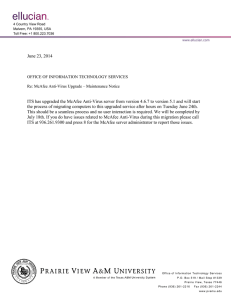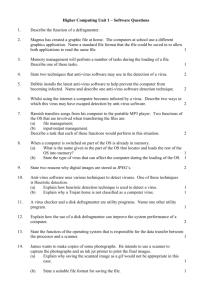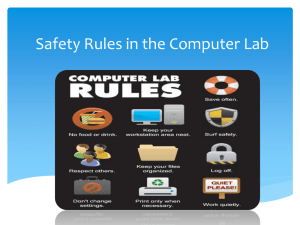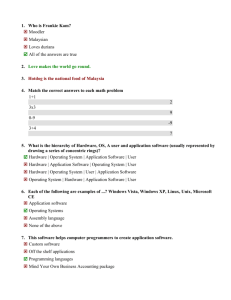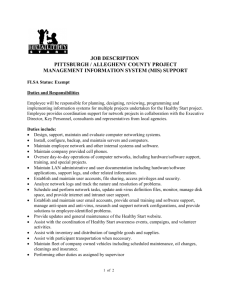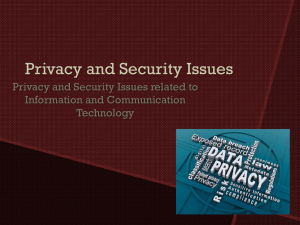Information Security (TDDC03) Project Spring 2007 Security and Usability of Anti-Virus Software
advertisement
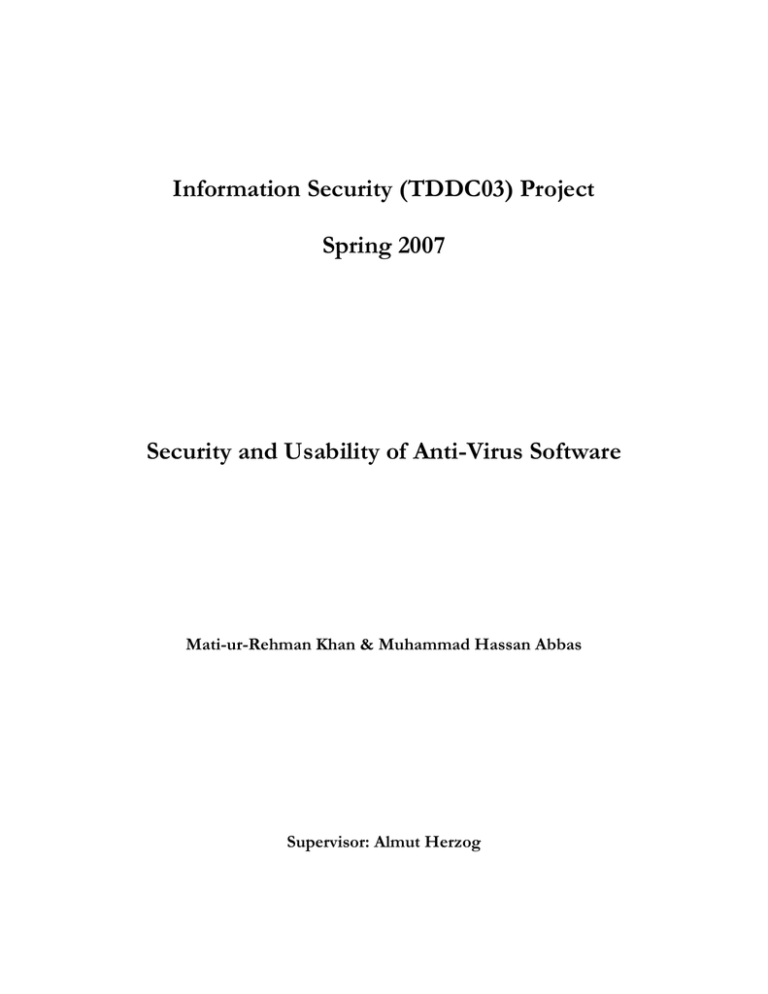
Information Security (TDDC03) Project
Spring 2007
Security and Usability of Anti-Virus Software
Mati-ur-Rehman Khan & Muhammad Hassan Abbas
Supervisor: Almut Herzog
Security and Usability of Anti-Virus Software
Mati-ur-Rehman Khan, Muhammad Hassan Abbas
Dept. of Computer and Information Science
Linköping University
Linköping, Sweden
{matkh777,muhab879}@student.liu.se
3.
Abstract
4.
In this comparison study we have evaluated the
security and usability of four types of anti-virus
software by installing them on a PC and
evaluating them to a security and usability test.
We downloaded four different anti-virus
software products, two of them are freeware and
two are evaluation versions of commercial
products. We have tested these with respect to
three criteria that we chose ourselves. Our
conclusion is that the security and usability of
anti-virus software is judged on how it updates
its virus databases and program updates.Also
how promptly it provides user with clear alerts
of what needs to be performed or had performed
to ensure the security of system. All of them have
some flaws, both in usability and security.
1. Introduction
Security of a computer system is an important
consideration. It is a critical issue for home users
and companies while deciding which product
should be used to prevent systems from Trojans,
viruses and malwares. In the market, anti-virus
products are available by many vendors, broadly
divided into two main categories i.e. freeware
anti-virus products or commercial anti-virus
products. All anti-virus software almost performs
the same functionality, so the decision may be
driven by recommendations, particular features,
availability, or price [2]. In this project we study
four anti-virus products and evaluate them
according to usability and security criteria. The
four anti-virus products that we evaluate are:
1.
2.
Norton Anti-virus 2007 by Symantec
Corporation.[3]
McAfee Virus Scan Plus 2007 by Network
Associates.[4]
2.
2.1
AVG Anti-virus Free Edition 7.5.467. by
Grisoft.[6]
Avast Anti-virus Home Edition 4.7.942 by
Alwil Software. [5]
Methodology
Selection Criteria
We decided to use these products because the
article “Who's Who in Anti-virus Software” by
Andy Patrizio dated August 2, 2006 [1] says that
Symantec has 54 % market share and its next
competitor is McAfee with 19 %. So we decided
to evaluate these two commercial top market
shareholders and two freeware products.
In our study the first two described products are
commercial and the last two are freeware. The
reason for choosing products from commercial
and free environment will help to judge whether
freeware software is more usable or secure then
commercial product or not.
3. How we evaluated
The evaluations were performed on a Pentium III
450 MHz PC with 512 MB RAM. The operating
system of the test computer was Windows XP
Professional, with Service Pack 2. We installed
anti-virus software one by one to test our criteria
on the system.
4. Evaluation Criteria
The criteria we choose to evaluate these products
are:
1. Update Procedure of anti-virus software: For :
For anti-virus software it is of utmost importance
that virus definitions are up to date and that
software vulnerabilities of the anti-virus software
are remedied as soon as possible. Therefore we
evaluate the update procedure of anti-virus
software
2. Performance of each product while performing
system scan and memory usage: For anti-virus
software scan time is important after installing
the anti-virus the user will always scan the
system for virus removal. In that case, usage of
memory resources and scanning time is
important. If anti-virus consumes a lot of
memory then it will create problem for the user
to do multiple tasks at the same time.
3. Evaluation of Product response by probing a
virus into the system to judge the behavior of
anti-virus software. Because it is of utmost
importance how anti-virus responds to a virus
attack.
5.1.3. AVG Anti-virus
One can install AVG Anti-virus by doubleclicking on the downloaded copy of AVG Free
Anti-virus Product. It takes about 5-6 minutes to
install it. It has the option of doing scanning
whole system, with the option of low memory or
high memory usage selection. At the end of
installation process it checks for updates to
update the product. It does not need a system
restart after installing the product.
5.1.4. Avast Anti-virus
One can install Avast Anti-virus by doubleclicking on the downloaded copy of Avast Antivirus Product. It takes about 4-6 minutes to
install it. It asks for setting up a boot time scan
on the system to check the system condition. It
needs a system restart after installing the
product.
We used a test file that has been provided by
EICAR (European Institute for Computer Antivirus Research) [7] for distribution as the
[EICAR Standard Anti-Virus Test File]. It is safe
to pass around this file because it is not a virus,
and does not include any fragments of viral code.
Most products react to it as if it was a virus
though they typically report it with an obvious
name, such as "EICAR-AV-Test". We opened
this file using Web Browser to view the results
of each anti-virus product.
5.2. Program and Virus Definitions
Updates
5.
Virus definition update is done after the
installation. In the later run you can right click
on the system try icon of McAfee Anti-virus and
click on the updates or you can go to Security
center and click on the update option. It
automatically checks for available updates about
virus definitions and program updates. An icon is
shown in the system tray about the progress.
Updates requires a system restart.
What we evaluated
5.1. Installation
5.1.1. Norton Anti-virus
One can install Norton Anti-virus by doubleclicking on the downloaded copy of Norton
Anti-virus. It takes about 12-15 minutes to install
it. It runs a pre-install scan on the system to
check the system condition. At the end of
installation process it asks for Live Update of the
program and virus definitions. Norton requires a
system restart after installation.
5.1.2. McAfee Anti-virus
One can install McAfee Anti-virus by doubleclicking on the downloaded copy of McAfee
Anti-virus Product. It takes about 14-16 minutes
to install it. It runs a pre-install scan on the
system to check the system condition. At the end
of installation process it checks for product and
virus updates to update the product. It needs a
system restart after installing the product.
5.2.1. Norton Anti-virus
The first definition update is done right after the
installation. After that Norton has the option to
allow Automatic Live Update. By default it is
turned on. One can configure Live Update in the
settings. System needs to be restarted after the
updates.
5.2.2. McAfee Anti-virus
5.2.3. AVG Anti-virus
First update of virus definitions is done at the
end of installation. In the later run you can right
click on the system try icon of AVG Anti-virus
and click on the check for updates or you can go
to control center and click on the check for
update option. It automatically checks for
available updates about virus definitions and
program updates. A window is opened showing
the information about the updates. System does
not needs to be restarted after the updates.
5.2.4. Avast Anti-virus
Avast does all the program and virus updates
automatically. One can also configure updates
manually. One can right click on the system try
icon of Avast Anti-virus and in the updating
section one can perform program updates or
virus definition updates. A popup is shown with
sound option when an update is done and system
restart is required.
5.3. Performance of System Scan and
Memory Usage
The performance of a virus scan was evaluated
on the same size of data for each product. The
data size according to Windows XP Folder
Properties was 3.00 GB, consisting of 7,146 files
and 622 folders.
5.3.1. Norton Anti-virus
The results we got after the Norton anti-virus
performs custom scan on the system shows that
it has performed scan in 17 minutes on 19336
files and folders. It does not show any clock
measurements, so we estimate it using the
system clock. We can choose any folder or drive
for
custom
scanning
purpose.
The results for memory usage, taken from the
Windows task manager during the above
scanning process, show that Norton anti-virus
consumes around 12,000 K to 13,832 K memory.
It also has the option to run the scan in
background. In that case memory usage is
extremely low i.e. 3,428 K.
spikes of memory usage between these two
limits. It is experienced that McAfee has many
ups and downs between these memory limits
during the whole process.
Time for Scan
Norton
McAfee
AVG
Avast
17
25
9:33
24:43
(Minutes: seconds)
Table1: Time for Scan by Anti-virus
5.3.3. AVG Anti-virus
You can perform a custom scan easily even on a
single directory. It took 9 minutes and 33
seconds to perform scan on the data. And the
results show that it scanned 15759 objects in all.
Scan summary shows duration measurements.
The results for memory usage, from task
manager during the above scanning process
show that AVG anti-virus consumes around
10,000 K to 29,000 K memory. It has different
spikes of memory usage between these two
limits. It is experienced that AVG has noticeable
ups and downs spikes between these memory
limits. In the start it was rather low like 10,000 K
to 13,000 K. Then in the middle and end of the
scanning process it was 25,000-27,000 K. Also
at the end it was stable to 29,000 K.
Norton
McAfee
AVG
Avast
12,000K 13,832K
30,000K 35000K
10,000K 29,000K
35,000K 40,000K
5.3.2. McAfee Anti-virus
To perform a custom scan using McAfee antivirus is a difficult task. It only allows system
created folders like My Documents etc. to have
the option of custom scan or particulate drives
like C:/ or D:/. It took 25 minutes to perform
scan on the data. It automatically scanned 30
processes and 252 cookies also. And the scan
results show that it scanned 7179 files in all. It
does not show any duration measurements, so we
have to calculate it manually checking the
starting time and subtracting it by using the last
scan
time
shown
by
McAfee.
The results for memory usage, from task
manager during the above scanning process
show that McAfee anti-virus consumes between
30,000 K to 35,000 K memory. It has different
Memory
Usage (K)
Table2: Memory Usage by Anti-virus
5.3.4. Avast Anti-virus
You can perform a custom scan easily even on a
single directory. It took 24 minutes and 43
seconds to perform scan on the data. And the
results show that it scanned 21642 files and 623
folders which is 3.7 GB of data. Scan summary
shows
duration
measurements.
The results for memory usage, from task
manager during the above scanning process
show that Avast anti-virus consumes around
35,000 K to 37,000 K memory. It has different
spikes of memory usage to 40,000 K. But mostly
it usage was shown between 35,000 K to 37,000
K.
5.4. Virus Probe Test
The virus probe was avalaible in four different
file formats i.e. as a DOS exe file, as text file, a
zip file containing that DOS exe file, and a zip
file containing another zip file with DOS exe
file.
For the second format AVG anti-virus didn't
detect this file as a virus at all.
For the zip files AVG didn't show alert at its
access. We were able to download and open the
zip file. But as we run this DOS file, it gives you
a warning and gives you options to deal with the
file.
5.4.1. Norton Anti-virus
5.4.4. Avast Anti-virus
Norton blocks the DOS file in exe and text
format and quarantines them, but for the zip files
Norton did not respond at its access. We were
able to download and open the zip file. But as we
run this DOS file, it prompts for action and
automatically blocks the content and quarantines
this file.
For the DOS exe and text format Avast Onaccess Scanner automatically detects the contents
as virus and ask you to abort the connection as
shown in figure 1.
In case of zip files when we click it we were not
able to download it. As soon as the browser tries
to store it in the Temporary Internet files Avast
On-access Scanner automatically detects the
contents as virus and ask you to abort the
connection.
6. Conclusions
Anti-virus software shows different results in
different scenarios. Some performed better in
memory usage, some outclassed others in time to
scan system and some gave good results in
founding the viruses.
Figure1: Avast Anti-virus alert for virus
5.4.2. McAfee Anti-virus
McAfee did not allow the DOS file access in exe
and text format. It blocks it and quarantine it in
the Temporary Internet files.
For the zip files McAfee didn't respond at its
access. We were able to download and open the
zip file. But as we run this DOS file, it prompts
for action and automatically blocks the content
and quarantines this file.
5.4.3. AVG Anti-virus
For the first format AVG stops the user from
downloading this file and prompts for action to
abort the connection.
6.1. Program and Virus Definition
Updates
In these criteria every anti-virus performed same.
Each of the four selected anti-viruses updated
their virus definitions and program updates after
the installation of the anti-virus. So there wasn’t
much difference in this regard. With the
increasing virus threats on freshly installed
systems it’s becoming a routine for almost all
anti-viruses to update their virus definitions and
program updates. A positive surprise was AVG
which does not require a restart after updating.
6.2. Performance of System Scan
The products’ performance during a system scan
was divided in two categories.
a.
How much time does each product take to
run a full scan on the same amount of
data?
The data size according to Windows XP Folder
Properties was 3.00 GB, which contains 7,146
files and 622 folders. Here AVG performed best
by scanning the system in 9 minutes and 33
seconds and the Norton scanned the system in 17
minutes. McAfee and Avast took almost the
same time to scan i.e. 25 minutes. Apart from
this Norton showed a very interesting result, that
it displayed different number of files and folders
scanned. It showed 19336 where as total files or
folders were 7768. Also, Avast showed in its
system scan screen, that it scanned 3.7GB of data
where as data on the disk by Windows Folder
Properties was 3 GB.
Memory Used During Scan
40000
Memory Usage K
35000
30000
Norton
25000
were able to find the virus activity on the second
mentioned test virus format, but AVG didn’t
considered it as a virus and allowed simple
execution of the file. For the third and fourth zip
format of the test virus, Norton, McAfee and
AVG were not able to identify it until it is
downloaded and executed on the system. But
Avast on the other hand discovered it as a virus
and didn’t allow the connection to move
forward. These results show that Avast was the
most useful anti-virus to successfully able to
identify test virus in all four formats. Norton and
McAfee are at the same level as they both
identify the first two file format viruses, but they
don’t do a deep on-access file scan. AVG was
the worst as it was unable to identify one of the
file formats test virus file.
McAfee
20000
AVG
15000
6.4. Results
Avast
10000
5000
0
0
2
4
6
8
No. of Antivirus
Figure2: Memory Used by Anti-virus
In one of the good point of the free-ware antiviruses (AVG and Avast) is that they have a
system clock built in which tells the time taken
to scan the system while this feature was absent
in McAfee and Norton.
b.
How much RAM (Read only Memory) is
used during scanning process.
Norton performed best in this case by utilizing
minimum amount memory and then there were
only minor differences in the rest of the antiviruses. One of the important or a positive aspect
of Norton was that it allows anti-virus to run in
the background and thus giving user freedom to
do other work at the same time.
So by observing the time consumed and memory
usage Norton performed better then other and
then AVG showed us good results also. There
wasn’t much difference in McAfee and Avast.
6.3. Virus Probe Test
Norton, McAfee, AVG and Avast were able to
find virus activity on the first file formats
described above. Norton, McAfee and Avast
The main purpose of anti-virus is to find viruses
at the right time; if it does not provide required
results then the purpose of the anti-virus
software is not fulfilled. So according to our
finding we give the following results. Norton
performed better in scanning system and in terms
of memory usage and was also able to finding
the viruses. Then Avast showed good results in
finding the viruses but was bit lacking behind in
terms of scanning and memory usage. McAfee
gave average results in every aspect where as
AVG performed poorly against the other antiviruses. AVG was good in scanning the system
but other than that it showed memory leaks and
performed badly in finding the viruses.
6.5. Commercial vs. Freeware
Commercial software (Norton) performed better
in less memory usage and finding viruses then
Freeware (Avast and AVG) but the difference
were surprisingly small. The decision of
selecting a particular anti-virus lies in the hand
of user.
7. References
[1] Andy Patrizio, Who's Who in Anti-virus
Software?, August 2, 2006.
http://www.internetnews.com/security/article.ph
p/3623881
Accessed on March 12, 2007
[2] Mindi McDowell, Allen Householder;
Copyright 2004 Carnegie Mellon University
http://www.us-cert.gov/cas/tips/ST04-005.html
[5] Avast Anti-virus Webpage
http.//www.avast.com
[6] AVG Anti-virus http://www.grisoft.com
Accessed on March 20, 2007.
[3] Norton Anti-virus Webpage
http://www.norton.com
[4] McAfee Anti-virus Webpage
http://www.mcafee.com
[7] European Institute for Computer Anti-virus
Research.
http://www.eicar.org/anti_virus_test_file.htm
Accessed on April 30, 2007.
